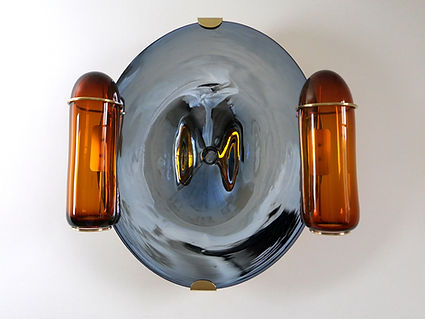Projects
Metis
Mètis is an ode to freedom and melancholy. The blue used, through a glass painting to become an allegory of freedom and melancholy, both paradoxical and complementary.
Between solitude, sadness, inner struggles, and appeasement, calm, breathing; the color blue alone is a contradictory representation of emotions.
Mètis, is the Greek goddess of prudence, wisdom, cunning, strategy and artisans. An Oceanid daughter of Ocean and Tethys. She is the mother of Athena, wife of Zeus, swallowed by the latter, she is represented by a character under the seat of Zeus, as the prompter of his ideas. Mètis is a common name in the ancient Greeks, which designates a particular form of intelligence. In its etymology, it means; knowledge, wisdom, skill, skill, art and cunning.
It designates natural abilities and acquired experience. “It concerns fluid realities which never cease to modify and which bring together in itself, at each moment, contrary aspects, opposing forces. »
Mètis is the art of connection. Mètis is used in this work to be a link. A link between know-how, A link between reflection and reality. It is a call to contemplation.
Mètis is the expression of a non-figurative contemplation of nature, in the manner of the romantic movement, whether pictorial or literary, it evokes the contemplation of human nature and nature itself. This current is the contestation of reason and the free expression of sensitivity. Romantic landscapes are irrational, the landscape then becomes the projection of the interior landscape.
Through artistic crafts, Mètis is a work which glorifies technique through the emotion given by the gesture and the creative intuition it provides, it evokes the paintings of sea side.



Brass and glass blown by mouth and freehand
410 x 370 x 50
creation 2023
photo credit: Estafania Sarti
Superbia



Since the beginning of Christian literature, the confrontation between vicesand virtues is persistent.
Among the vices, the most serious of the seven deadly sins is the sin of pride, called Superbia.
Over the centuries, pride, Superbia, has been represented by a woman leaning over a mirror.
These female figures are almost always accompanied by a creature which seems to encourage them to look at each other.
I propose here as a reflection: the place of vanity, feminine and thoughtful, which frustrates more than it satisfies. If ne listened to these creatures who whisper to us to ear, would we see ourselves as we are?
Imagined as a mirror of frustration, represented at using a concave shaped cive, thus disturbing the thinking skills that are usually expected of the mirror object.
Continuing the frustration created by the mirror, the cylinders echo this desire to surprise and to disturb "the viewer", to use Marcel Duchamps' expression.
Inspired by mirrors from the Art Deco era, this mirror is part of the desire to combine two know-how in within the pieces I create: glassblowing à la bronze cane and mount. The approach, beyond the sensory and aesthetic aspect, is also to work around the flame. The choice of colors and techniques used translates the power of fire, glass
being a material that is worked with heat and using point of a torch.
The two orange shapes that cut out the mirror in the only place where looking at it could be reflected. Depending on the location of observation, the orange and indigo reflections vary.
Brass and glass blown by mouth and freehand
560x550x20
Creation 2022
photo credit: Estafania Sarti
Cerulean
Fire is a source of light which provokes attraction and rejection in the viewer, because this element is at the same time hypnotic, impalpable and uncontrollable. This is why my centerpiece uses the flame to create a warm and festive atmosphere while guaranteeing the safety and simplicity of using a candle.
This light fixture is used as an ethanol fireplace. It is made up of a glass sculpture encompassing a structure composed of three brass elements, which contains the tank. A first orange-yellow flame develops between the two outer sheets, and a second, smaller and bluish, around the central metal element. These two colors recall the bivalence of fire.


Cold deformed brass, cast bronze, ethanol
350 x 250
Witness

Witness is here representative of the mark we have of our past and the trials endured. Thought of as a supportive pair, with strength and fragility.
Like the stigmata, it is a symbol of the importance of understanding what indelible traces we carry within us, on us, to be able to compensate for them, sublimate them through the impact of our future actions and our creations.
The impact of creation on our mind and on our reconstruction.
The shapes echo each other, are linked together and cannot exist without each other.
A union resulting from numerous imprints and modifications.
The element supporting the glass vase, deformed by a scar given during hot working of the glass, comes from the cutting of the main element of the brass vase to accommodate the smooth part of the blown piece.
Thus, the elements are co-dependent on their balance and thus create a new one.
Brass assembled hot and cold, polished / satin Hot blown and sculpted glass
180 x 100 x 340mm
Ludivine Loursel
creation 2023
photo credit: Marie Rolland